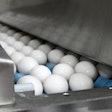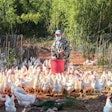
In cage-free housing systems, there is an increased risk of infectious diseases developing in hens because birds can come into contact with feces, other birds and pests, causing a financial issue for egg producers.
According to John Brown, DVM, Zoetis Senior Technical Services Veterinarian, conventional and cage-free producers often see the same diseases, however, cage-free producers are likely to see those diseases have a more harmful impact on their flocks.
“Escherichia coli (E. coli) infections are seen in all production systems, but more frequently in cage-free systems by virtue of the increased exposure to dust and manure. Likewise, Salmonella is thought to be more prevalent in cage-free production,” he stated. Additionally, Spotty Liver Disease or internal parasites are more common in birds that have outdoor access.
Brown explained that mortality from E. coli can cause a significant financial loss to producers, with mortality rates potentially reaching 0.3% per week or more. If there is a Salmonella enteritidis infection, eggs could be sent to the breaker, which often is a financial loss, or the flock could be depopulated.
“Spotty Liver Disease reduces production and causes increased mortality, reducing the overall flock income,” he said.
How are producers handling these diseases?
Brown said E. coli is currently addressed through vaccination, improved sanitation of water lines and sources and an intense cleaning regime between flocks. Brown suggests that producers implement a vaccination program that includes two E. coli vaccinations during the pullet phase, and potentially one or more additional vaccinations in the layer house.
“Vaccination against infectious bronchitis and maintaining good gut health are important in controlling E. coli infections,” he stated. “Good ventilation and uniform air flow will also help reduce the amount of inhaled E. coli.”
Salmonella is currently addressed by vaccinating at least twice with a live vaccine and once with an inactivated vaccine during the pullet phase. Salmonella control programs should also consist of strict rodent and insect control to improve biosecurity in cage-free housing, he explained.
Spotty liver disease can be controlled by use of autogenous vaccines, acidification of water and cooling the house down.
“With any disease, thorough disinfection between flocks and good rodent and insect control are paramount,” he added.


















